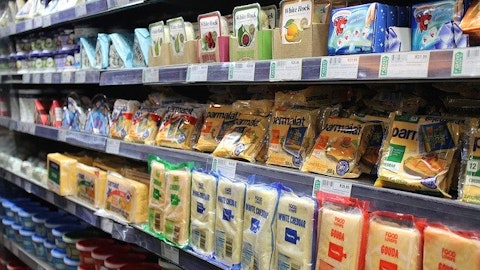Scott Mushkin: Hey, guys. Thanks for taking my questions. So I was wondering, if I could get some clarification. You mentioned tuck-in acquisitions and adding to 2024 EBITDA just kind of trying to understand the scale of that and how close you are to making some of those acquisitions.
Tony Sarsam: Yeah. As I mentioned here this is Tony, Scott. And I think I mentioned this also the last time we talked we’re actively sort of evaluating opportunities in the M&A space. I think we’ll you’ll see us both actively evaluated as I mentioned also, I think we’re looking at a number of options to shore up the overall — our overall business offering looking for in broadly in the space we play. I think I mentioned this last time there are likely to be more of them in Retail stores. And so we have probably more — that we’re evaluating in that space than in the Wholesale space. But we see that as a really, really important way for us to get our business sort of growing and support our overall mission to deliver the ingredients for better life. We add those things that actually make the business we currently have stronger. And we see plenty of opportunities out there. So, you’ll see that over the course of time as we move through these next couple of years.
Scott Mushkin: And I had a follow-up to that Tony, but I was wondering about the EBITDA question that I mentioned how much scale it as far as your forecast for 2024?
Jason Monaco: Hey, Scott, this is Jason. I think about these as pretty small acquisitions that scale in margin but really represent a small — relatively small contribution to company performance. These are things that fit in our geographies, fit in our footprint and are synergistic to what we do — but you should think about these as relatively small in the context and that’s what’s incorporated into the plan. What we’re trying to do is give investors and folks like yourself real good clarity on where we’re headed. And if you kind of wind back the clock, we at our Investor Day a couple of years ago we talked about our M&A strategy. And we talked about how we would think about M&A and nothing’s, frankly, changed on that front.
What we’ve done is really executed on our organic plans and built the framework to execute both organic and then inorganic that sits on top of it. So what we want to share is that we’re ready to kind of continue to move that forward, consistent with the strategy we laid out a couple of years ago. But frankly, we had to do some of our own internal house cleaning things first. And now we’re moving into the inorganic elements and we’ll stack that on top of our strategic plan.
Scott Mushkin: And just a follow-up to what Tony said. Are these wholesale customers currently that you think this is going to take place? Or is this, retailers that maybe you guys aren’t servicing right now?
Tony Sarsam: We’re certainly evaluating both of those options?
Scott Mushkin: Okay. I have more questions, but I’ll leave you there.
Operator: Our next question comes from Andrew Wolf from CL King. Your line is open.
Andrew Wolf: Hi. Good morning. I just want to ask about the gross profit dollar trend, pre-LIFO like FIFO gross profit has been down and sort of at an accelerating pace. Is that a lot of comparing to the year ago gains in inventory holdings? Or is that more price competition in the market? What is the biggest driver there of your — what’s going on with gross profit dollars and margin pre-LIFO again, exclusive of the LIFO changes? And secondly, how does that — when does that stabilize in your view, particularly with regard to the 2024 guidance? Thank you.
Jason Monaco: Hey, Andrew, this is Jason. Thanks for the question. And so, maybe touching on the very first element and you mentioned this in your question. The gross margin of course has been weighed down by the kind of wind down of inflation-related price gains that we’ve been projecting. So, it’s kind of nothing new on that front. And it’s been offset or largely offset by the transformational programs in both supply chain and merchandising at the gross margin level. When I think about our gross margin overall, across the business we delivered a margin pickup versus prior year. But we, obviously, looking back a couple of years, we’re still winding down from the inflation-related gains, and that’s weighing on the results.
Andrew Wolf: Do you evaluate the business on a LIFO basis or a FIFO basis for gross profit?
Jason Monaco: FIFO.
Andrew Wolf: I mean your EBITDA takes out LIFO, right?
Jason Monaco: Right.
Andrew Wolf: All right. I’ll move on from that. Can you just talk about sort of the Wholesale business, if you will, in terms of which is holding up better than retail right now understandably, how competitive the consumer is? But how do you — how is inflation in wholesale and sort of how is volume holding up? And I know the market is what it is but just specifically more for SpartanNash?
Tony Sarsam: Yes. So the Wholesale business, overall, continues to perform well. We had, as mentioned on the call part of the wholesale equation is the Amazon business, which is they are, as I mentioned earlier, they’re resetting their expectations and finding a way to get a retail offering that makes sense for them. And so they pulled back. So that kind of covers the overall volume perspective in our Wholesale. But independents performing kind of roughly the same as our Retail — our own Retail stores. Our military business is going to be strong. We’re going to have a second really good year with military and good growth there. So, overall, our military, our national accounts ex-Amazon and our independent grocers are sort of performing at expectation.



